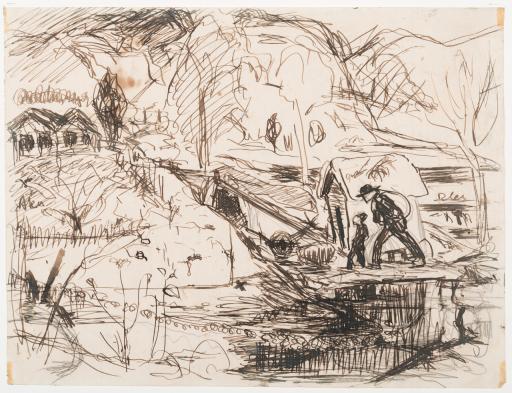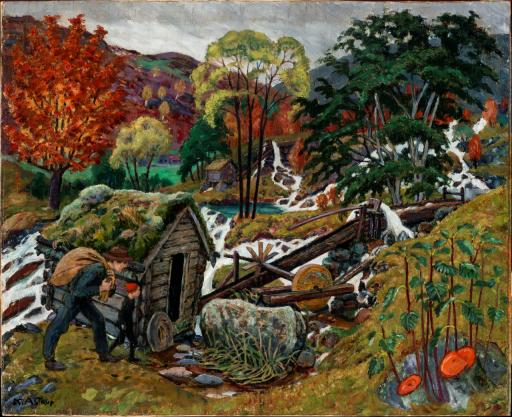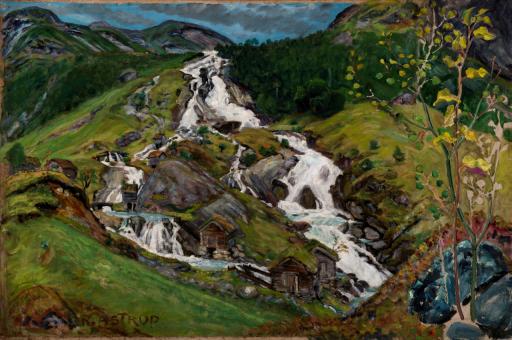Provenance
1916-1916:
Artist
Nikolai Astrup
(1880-1928)
1916-n.d.:
In custody of
Moritz Kaland
(1869-1947)
-1927-1950-:
Purchased by
Thorvald Halvorsen
(1879-1950)
-1955-1971:
Unknown acquisition method
Halfdan Arnold Grieg
(1907-1971)
1971-1989-:
By descent, to
Private owner
-1989-2005:
Privately purchased by
Private owner
Exhibition history
Solo exhibition
1928-11-11 - 1928-12-9
Nikolai Astrup. Mindeutstilling
Kristiania (Oslo)
Catalogue number 68
See exhibition
1994-9-17 - 1994-11-13
Nikolai Astrup. Tradisjon og overskridelse
Oslo
Catalogue number 29
See exhibition
1994-11-20 - 1995-1-15
Nikolai Astrup. Tradisjon og overskridelse
Stavanger
Catalogue number 29
See exhibition
1995-2-2 - 1995-3-5
Nikolai Astrup. Tradisjon og overskridelse
Lillehammer
Catalogue number 29
See exhibition
1995-3-18 - 1995-5-7
Nikolai Astrup. Tradisjon og overskridelse
Bergen
Catalogue number 29
See exhibition
1995-5-15 - 1995-9-15
Nikolai Astrup. Tradisjon og overskridelse
Jølster
Catalogue number 29
See exhibition
2005-1-15 - 2005-2-27
Nikolai Astrup. Tilhørighet og identitet
Tønsberg
Catalogue number [no]
See exhibition
2005-3-11 - 2005-5-1
Nikolai Astrup. Tilhørighet og identitet
Drammen
Catalogue number [no]
See exhibition
2005-5-24 - 2005-8-14
Nikolai Astrup. Tilhørighet og identitet
Bergen
Catalogue number [no]
See exhibition
2005-8-28 - 2005-10-23
Nikolai Astrup. Tilhørighet og identitet
Stavanger
Catalogue number [no]
See exhibition
2005-11-6 - 2006-1-1
Nikolai Astrup. Tilhørighet og identitet
Trondheim
Catalogue number [no]
See exhibition
2006-2-11 - 2006-3-26
Nikolai Astrup. Tilhørighet og identitet
Kristiansand
Catalogue number [no]
See exhibition
2006-5-20 - 2006-8-13
Nikolai Astrup. Tilhørighet og identitet
Jølster
Catalogue number [no]
See exhibition
2006-8-26 - 2006-10-1
Nikolai Astrup. Tilhørighet og identitet
Notodden
Catalogue number [no]
See exhibition
2006-10-14 - 2006-12-30
Nikolai Astrup. Tilhørighet og identitet
Lillehammer
Catalogue number [no]
See exhibition
2016-10-2 - 2017-1-22
Nikolai Astrup: Norwegen. Eine Entdeckung
Emden
Catalogue number 69
See exhibition
Group exhibition
Bibliography
Bergens Kunstforening. Nikolai Astrup 1880–1928. Mindeutstilling. Bergen: Bergens kunstforening, 1928.
Loge, Øystein. Nikolai Astrup: tradisjon og overskridelse. [Høvikodden]: Henie-Onstad kunstsenter, 1994.
Carey, Frances; Dejardin, Ian A. C.; Stevens, MaryAnne (ed.). Norske landskap. Nikolai Astrup (1880–1928). London: Scala Arts & Heritage Publishers Ltd, 2016.
Carey, Frances; Dejardin, Ian A. C.; Stevens, MaryAnne (ed.). Painting Norway. Nikolai Astrup (1880–1928). London: Scala Arts & Heritage Publishers Ltd, 2016.
Stevens, MaryAnne, et al. Nikolai Astrup. Rå natur. Bergen: KODE, 2021.
Stevens, MaryAnne, et al. Nikolai Astrup. Visions of Norway. Williamstown, Massachusetts: Clark Art Institute, 2021.
Loge, Øystein. Gartneren under regnbuen. Hjemstavnskunstneren Nikolai Astrup. Oslo: Dreyers Forlag, 1990 [1986].
Korsvold, Per. «Maleren fra Jölster». Samleren, 8 (1931): 101–108.
Danbolt, Gunnar. Norsk kunsthistorie. Oslo: Samlaget, 2009 [1997].
Loge, Øystein; Brynildsen, Jon Chr.. Nikolai Astrup: Blomsten, berget og St. Hansnatten. Oslo: Quorom, 1994.
Greve, Kari. «Katalog». In Nikolai Astrup. Tresnitt, ed.: Greve, Kari, 63–248. Oslo: Labyrinth Press, 2010.
Loge, Øystein. Nikolai Astrup. Elskaren under trekrona. Oslo: Det Norske Samlaget, 2005.


